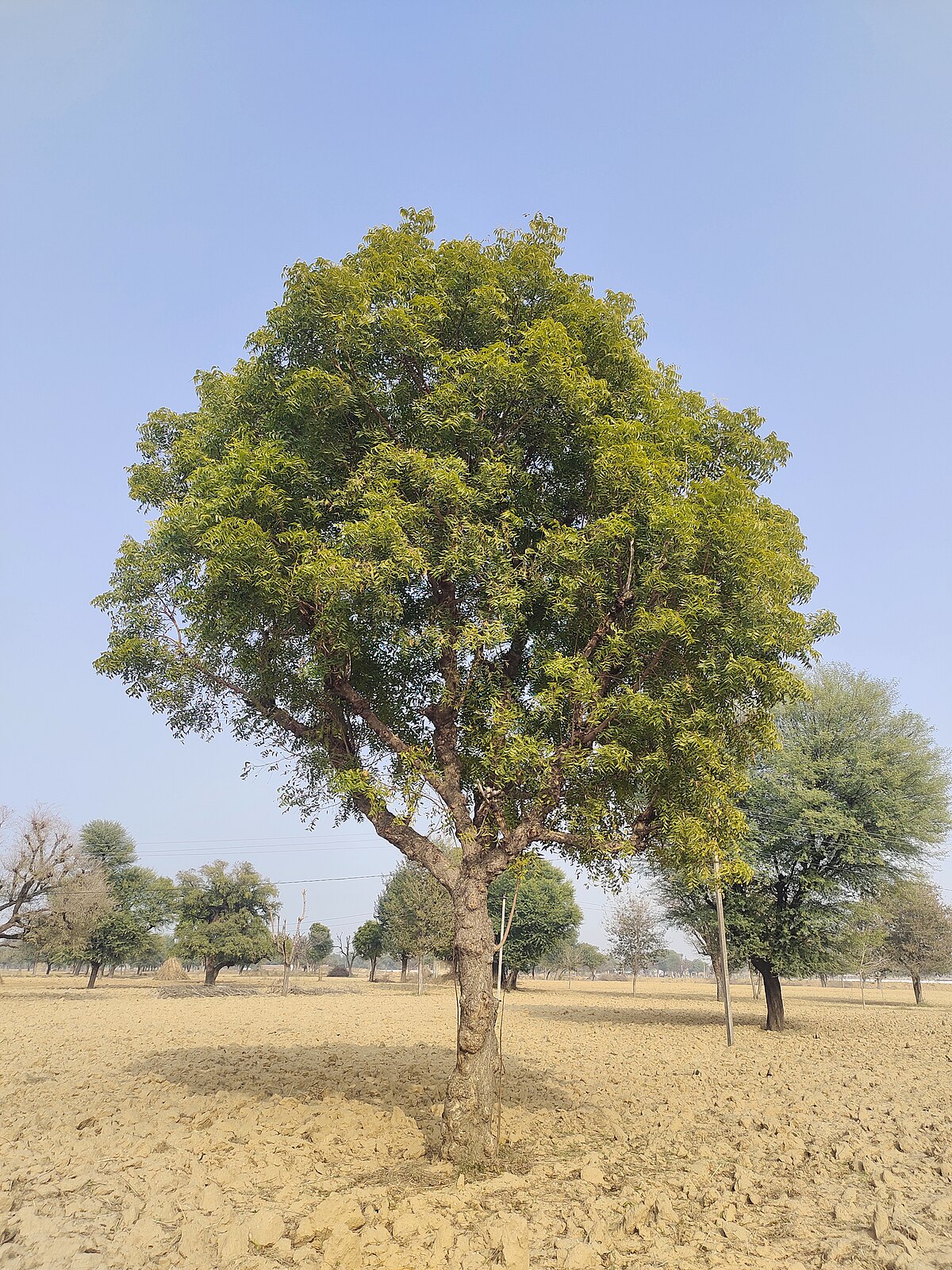Neem
- Family: Meliaceae
- Local Names: Amharic (kinin), Arabic (nim,neem), Bengali (nimgach,nim), Burmese (bowtamaka,thinboro,tamarkha,tamar,tamaka,tamabin), Cantonese (nimba,kohomba,bevu), Chamorro (sdau), Creole (nim), English (Persian lilac,neem tree,bastard tree,Indian lilac,bead tree)
Description
1. Azadirachta indica is a small to medium-sized tree, usually evergreen, up to 15 (30 max.) m tall, with a round, large crown up to 10 (20 max.) m in diameter; branches spreading; bole branchless for up to 7.5 m, up to 90 cm in diameter, sometimes fluted at base; bark moderately thick, with small, scattered tubercles, deeply fissured and flaking in old trees, dark grey outside and reddish inside, with colourless, sticky foetid sap.
2. Leaves alternate, crowded near the end of branches, simply pinnate, 20-40 cm long, exstipulate, light green, with 2 pairs of glands at the base, otherwise glabrous; petiole 2-7 cm long, subglabrous; rachis channelled above; leaflets 8-19, very short petioluled, alternate proximally and more or less opposite distally, ovate to lanceolate, sometimes falcate (min. 2) 3.5-10 x 1.2-4 cm, glossy, serrate; apex acuminate; base unequal.
3. Inflorescence an axillary, many-flowered thyrsus, up to 30 cm long; bracts minute and caducous; flowers bisexual or male on same tree, actinomorphic, small, pentamerous, white or pale yellow, slightly sweet scented; calyx lobes imbricate, broadly ovate and thin, puberulous inside; petals free, imbricate, spathulate, spreading, ciliolate inside.
4. Fruit 1 (max. 2)-seeded drupe, ellipsoidal, 1-2 cm long, greenish, greenish-yellow to yellow or purple when ripe; exocarp thin, mesocarp pulpy, endocarp cartilaginous; seed ovoid or spherical; apex pointed; testa thin, composed of a shell and a kernel (sometimes 2 or 3 kernels), each about half of the seed’s weight.
Ecology
A. indica is said to grow ‘almost anywhere’ in the lowland tropics. Under natural conditions, it does not grow gregariously. In India, it is present in mixed forest with Acacia spp. and Dalbergia sissoo; in Indonesia, it is naturalized in lowland monsoon forest. In Africa, it is found in evergreen forest and in dry deciduous forest. Adult A. indica tolerates some frost, but seedlings are more sensitive. It quickly dies in waterlogged soils. A. indica requires large amounts of light, but it tolerates fairly heavy shade during the 1st few years.
Native range
India, Indonesia, Malaysia, Myanmar, Pakistan, Senegal, Sri Lanka, Thailand
Tree Management
1. Weeding of A. indica plantations in dry areas is essential, as the tree cannot withstand competition, especially from grasses. It responds well to chemical and organic fertilizers. Trees coppice freely, and early growth from coppice is faster than growth from seedlings. A. indica withstands pollarding well, but seed production is adversely affected when trees are lopped for fodder.
2. Seed storage behaviour is probably intermediate. Viability is reduced from 85% to 60% after 1 month hermetic air-dry storage at room temperature and to 45% at 6 deg. C. There are about 4000-4500 seeds/kg.
3. A. indica is said to grow ‘almost anywhere’ in the lowland tropics. Under natural conditions, it does not grow gregariously. In India, it is present in mixed forest with Acacia spp. and Dalbergia sissoo; in Indonesia, it is naturalized in lowland monsoon forest. In Africa, it is found in evergreen forest and in dry deciduous forest. Adult A. indica tolerates some frost, but seedlings are more sensitive. It quickly dies in waterlogged soils. A. indica requires large amounts of light, but it tolerates fairly heavy shade during the 1st few years.
4. A. indica is easily raised in the nursery and planted out as potted plants or seedlings. Direct sowing of fresh seeds in the shelter of existing vegetation has also proved successful. No seed pretreatment is required, although depulping and cleaning of seeds considerably improves the germination rate. Mature seeds germinate within a week, with a germination percentage of 75-90%. Neem can also be propagated vegetatively by air-layering, root and shoot cuttings, grafting, marcotting and tissue culture.
Timber
A. indica is a species of the mahogany family, and although it has some of the characteristics of a cabinetry wood, its grain is rough and does not polish well. The wood is, nevertheless, used to make wardrobes, bookcases and closets, as well as packing cases because its insect repellent quality helps to protect the contents from insect damage. The main stem of the tree is also widely used to make posts for construction or fencing because the wood is termite resistant. The density of the wood is 720-930 kg/cubic m at 12% mc.
Shade or Shelter
The large crown of A. indica makes it an effective shade tree, planted widely as an avenue tree in towns and villages and along roads in many tropical countries. Because of its low branching, it is a valuable asset for use as a windbreak.
Medicine
Neem has proved effective against certain fungi that infect humans. In a laboratory study, neem preparations showed toxicity to cultures of 14 common fungi. The tree has suppressed several species of pathogenic bacteria, including Salmonella typhosa and Staphylococus aureus. Various parts of A. indica have anthelmintic, antiperiodic, antiseptic, diuretic and purgative actions, and are also used to treat boils, pimples, eye diseases, hepatitis, leprosy, rheumatism, scrofula, ringworm and ulcers. Leaf teas are used to treat malaria. People use the twigs as toothbrushes, and dentists find twigs effective in preventing periodontal disease. Neem oil is a powerful spermicide and can therefore be used as an inexpensive birth control method. A neem oil-based product, Sensal, is being marketed in India as an intravaginal contraceptive. Neem oil has been used traditionally as a topical treatment for skin symptoms in both humans and livestock, but it should not be ingested orally.
Gum or Resin
An exudate can be tapped from the trunk by wounding the bark. This high-protein material has potential as a food additive and is widely used in Southeast Asia as ‘neem glue’.


